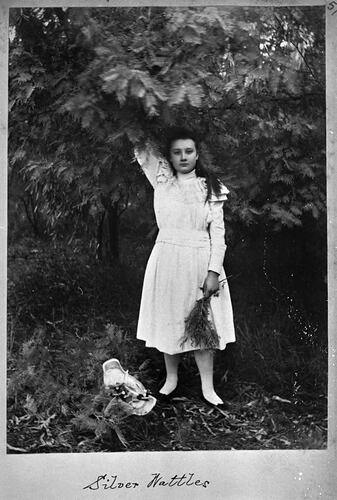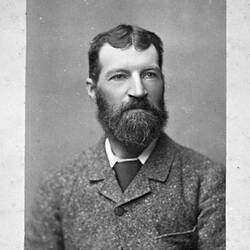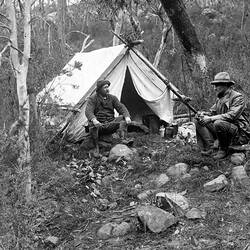Summary
This photograph was taken by Archibald James Campbell in preperation for his book 'Golden Wattle: Our National Floral Emblem' which he published in 1921. The frontispiece of the book declares it is "a particularly unique series of photo-pictures of Wattles, or Australian Acacias, in full flower (with the introduction of a fugre for idealistic purposes), and some scences of Wattle Wilds, together with descriptive letterpress." This particular image did not make it into the final edition.
A well known Naturalist, Campbell argued for recognition of Wattle as a symbol of Australian patriotism. Campbell promoted spring excursions in search of wattle to establish the Wattle Club in 1899, and conduct annual expeditions on 1 September to collect wattle. In 1908 he delievered a lecture which became very popular, "Wattle Time; or Yellow-haired September," and in it he advocated for a National Wattle Day. Wider acceptance of a national Wattle Day was achieved at a major Australian Wattle Day League Conference in Melbourne in January 1913. Branches were formed in a number of States, with the general aim of officially proclaiming wattle as the national floral emblem and extending Wattle Day celebrations throughout the nation. About this time, wattle was officially introduced to representations of the Commonwealth coat-of-arms. And in December of the same year, the first wattle blossom stamp was issued. As public support for Wattle Day reached a peak, World War I broke out. Wattle took on a new significance in the war years as a potent symbol of home for military personnel serving overseas, and as a means of raising money for organisations such as the Red Cross. Beautifully designed Wattle Day badges as well as wattle sprigs were sold. Ironically, the destruction of wattle for Wattle Day displays and fund-raising sales reached such heights that farmers within an hour of Melbourne locked their gates and wrote angry letters to newspapers. The use of badges depicting wattle instead of actual wattle saved many blooms. Campbell was also one of the first nature photographers in Australia. Campbell's adoration of the Wattle and his nature photography come together in this series of images. Campbell notes that this variety of Wattle, Acacia dealbat is "prime only when planted by a stream, spring or soak; attain a great size."
Description of Content
A young girl stands reaching up into a wattle tree. She holds a spray of wattle in her left hand and there is a basket containing wattle sprays at her feet.
More Information
-
Collection Names
-
Collecting Areas
-
Acquisition Information
Transfer from Natural Science, Museum Victoria
-
Place & Date Depicted
-
Creator
-
Format
Photograph, Black & White
-
Classification
-
Category
-
Discipline
-
Type of item
-
Dimensions
11 mm (Width), 16 mm (Height)
-
Keywords


